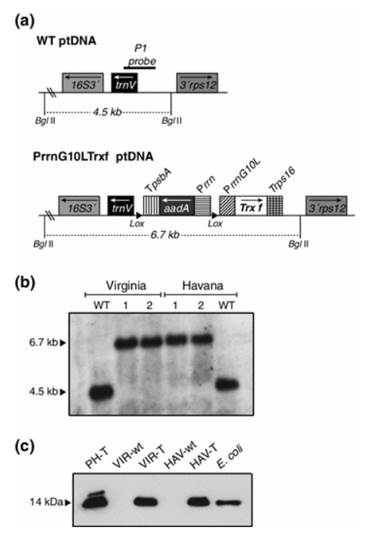

烟草是可多次收割的高密度作物,每公顷可生产多达160吨鲜物质,成为生产生物乙醇的生物质来源。农业生物技术研究小组领头人Jon Veramendi解释:“烟草作为生产生物乙醇的生物质来源,可替代美国和欧洲正在下降的传统烟草种植,因为这些地区不能与中国这样的新兴国家竞争。”
在研究期间,研究结果发表在《分子育种》,金弗吉尼亚和雪茄两种商业烟草品种已经种植。植株通过转基因增加淀粉和糖产量,这有助于增加乙醇产量。 这项工作主要是NUP/UPNA 在读博士Ruth Sanz-Barrio的博士论文。研究人员Imma Farrán、Jon Veramendi、Alicia Fernández-San Millán、María Ancín和Luis Larraya参与了这项工作。
正如Veramendi教授解释:“现在需要做的工作是这两个烟草品种的田间调查,事实上调查发现烟叶的淀粉和糖含量更高。”传统的烟草种植需要植株不停发育而使叶片长得更大,因为烟碱合成随着植株的成熟度而增加。然而,如果植株用于生产生物燃料,那么研究者偏好饲料作物相似的高密度种植:“烟草植株密集播种以及整个生长期间多次收割。植株长到约50厘米高就会收割并输送到生物质加工厂。这样,整个周期每公顷有可能收获高达160吨的生物质。”
更重要的是,当烟草被集装到生物精炼厂,可能提取有价值的副产物,如蛋白(构成了30%植株干重,其营养更完整,并有比牛奶或豆浆更大的蛋白效率,所以可以用来喂养人类或动物),solasenol(用于生产维生素E和K)和叶黄素(鸡饲料添加剂)。
在过去的十年中,欧洲烟草种植面积烟已经削减了45%。西班牙主要烟区是埃斯特雷马杜拉,其次是安达卢西亚。研究者认为,传统烟草用途的替代选项是生产生物燃料。从现在开始,需要进行高密度栽培试验,确定小面积田间种植调查结果是否得到验证。(编译:中国科学院成都生物研究所 王芋华,王海燕)
Increased bioethanol production from commercial tobacco cultivars overexpressing thioredoxin f grown under field conditions
Abstract Bioethanol is mainly produced from food crops such as sugar cane and maize, and this has been held partly responsible for the rise of food commodity prices. Tobacco, integrated in biorefinery facilities for the extraction of different compounds, could become an alternative feedstock for biofuel production. When grown for energy production, using high plant densities and several mowings during the growing season, tobacco can produce large amounts of inexpensive green biomass. We have bred two commercial tobacco cultivars (Virginia Gold and Havana 503B) to increase the carbohydrate content by the overexpression of thioredoxin f in the chloroplast. Marker-free transplastomic plants were recovered and their agronomic performance under field conditions was evaluated. These plants were phenotypically equivalent to their wild types yet showed increased starch (up to 280 %) and soluble sugar (up to 74 %) contents in leaves relative to their control plants. Fermentable sugars released from the stalk were also higher (up to 24 %) for transplastomic plants. After heat pretreatment, enzymatic hydrolysis and yeast fermentation of leaf and stalk hydrolysates, an average of 20–40 % more ethanol was obtained from transplastomic plants than their wild-type controls. We propose an integral exploitation of the entire tobacco plant managed as a forage crop (harvesting sugar and starch-rich leaves and lignocellulosic stalks) that could considerably cheapen the entire production process.
原文链接:http://download.springer.com/static/pdf/129/art%253A10.1007%252Fs11032
-014-0047-x.pdf?auth66=1397718141_5c25a4e660f4b639525356135cac95a8&ext=.pdf



